I remember covering the American government and the United States Supreme Court in middle school. However, even though we briefly covered it in school, I was not aware of the complexities and inner workings that laid out the groundwork of the Supreme Court.
Beginning with multitudes of petitions, which are sent to the court by a variety of American individuals, nine justices analyze the cases to decide which ones are worthy of their attention. These petitions can range from an unjust ruling from a lower court, which the petitioner wants overturned; to a wrongly convicted American citizen writing the petition in his own hand. Even though one petition may seem more legit than the other, the justices hold no biases when it comes to deciding what cases they are going to take. They analyze each case equally and fairly and draw from the United States Constitution to uphold the rule of law, which has shaped the American Justice system for years. The power of the Supreme Court comes from the ability to reshape government boundaries as they are the bridge between the States, Congress, and the President.
What I found interesting was the fact that throughout all of American history, there have been just over
one hundred Supreme Court Justices. Even though the President appoints them, Supreme Court justices tend to serve on the court for decades after that president has been in office. I believe these life terms are beneficial to upholding the structure and integrity of the court as it allows for American legislation to stand strong in its beliefs.

However, even though American citizens respect and trust the Supreme Court, it was not always that way. Another thing I found interesting was the court's decision on the Dred Scott case, which stated that black people would not be seen as citizens of the United States. This decision caused the public to question the court's authority and led to the Civil War. While I had heard of the Dred Scott case, I was not aware of how large of an upheaval it caused and that after the war ended, the Constitution was amended to grant voting rights and citizenship to black people. Not only does this showcase the power that the Supreme Court holds, but it also is an example of the significant influence the Supreme Court has when it comes to American Legislation.

For me, the most important takeaway point is the fact that the Supreme Court is the bridge between the Executive branch, the Legislative branch, and the American people. The justices have the power to give a voice to the voiceless and allow the legal system to run as smoothly as possible. Another takeaway that I found interesting was the fact that the Justices are not trying to sell everyone their opinions on the briefs. They are simply asking questions that allow the court to have a conversation with itself through the channels of the attorneys.
These two videos changed the way I view the Supreme Court as it lays out the complex process that goes on within the American legislative system. What I learned in middle school, does not even begin to cover the intricacies that the justices deal with on a day-to-day basis. I am fascinated by the power the Supreme Court holds on not only American politics but also on the legal system as a whole.

















